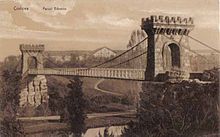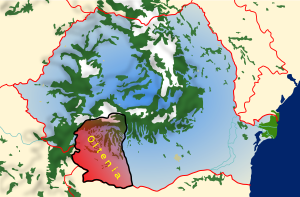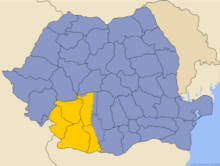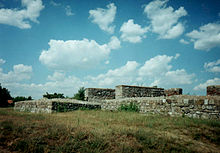- Oltenia
-
Oltenia (Romanian pronunciation: [olˈteni.a], also called Lesser Wallachia in antiquated versions, with the alternate Latin names Wallachia Minor, Wallachia Alutana, Wallachia Caesarea between 1718 and 1739) is a historical province and geographical region of Romania, in western Wallachia. It is situated between the Danube, the Southern Carpathians and the Olt river (although counties in the east extend beyond the river in Muntenia in some areas).
Contents
Geography
 Suspended bridge in Craiova's Park
Suspended bridge in Craiova's Park Horezu Monastery - UNESCO World Heritage
Horezu Monastery - UNESCO World Heritage Brancusi - The Endless Column in Târgu Jiu
Brancusi - The Endless Column in Târgu Jiu
Oltenia entirely includes the counties:
and parts of the counties:
- Mehedinţi (mainly in Oltenia, but the western part belongs to Banat)
- Vâlcea (mainly in Oltenia, but the eastern part belongs to Muntenia)
- Olt (the western half, the former Romanaţi county)
- Teleorman (only the village Islaz)
Nowadays, Oltenia's main city and its seat for a long period of the late Middle Ages is Craiova. The first medieval seat of Oltenia was Turnu Severin of Banat of Severin, the ancient Drobeta, near the former Roman bridge, built by Apollodorus of Damascus for Emperor Trajan conquest purposes.
Complete list of towns from Oltenia
City
County
Population
Craiova Dolj 302,601 Râmnicu Vâlcea Vâlcea 107,656 Drobeta-Turnu Severin Mehedinţi 104,035 Târgu Jiu Gorj 96,562 Slatina Olt 87,335 Caracal Olt 34,603 Motru Gorj 25,860 Balş Olt 23,147 Drăgăşani Vâlcea 22,499 Băileşti Dolj 22,231 Corabia Olt 21,932 Calafat Dolj 21,227 Filiaşi Dolj 20,159 Dăbuleni Dolj 13,888 Drăgăneşti-Olt Olt 13,181 Rovinari Gorj 12,603 Strehaia Mehedinţi 12,564 Bumbeşti-Jiu Gorj 11,882 Băbeni Vâlcea 9,475 Târgu Cărbuneşti Gorj 9,338 Călimăneşti Vâlcea 8,923 Segarcea Dolj 8,704 Turceni Gorj 8,550 Brezoi Vâlcea 7,589 Tismana Gorj 7,578 Horezu Vâlcea 7,446 Vânju Mare Mehedinţi 7,074 Piatra Olt Olt 6,583 Novaci Gorj 6,151 Potcoava Olt 6,111 Bălceşti Vâlcea 5,780 Baia de Aramă Mehedinţi 5,724 Berbeşti Vâlcea 5,704 Ţicleni Gorj 5,205 Băile Olăneşti Vâlcea 4,814 Bechet Dolj 3,864 Ocnele Mari Vâlcea 3,591 Băile Govora Vâlcea 3,147 History
Initially inhabited by Dacians, Oltenia was incorpored in the Roman Empire (106, at the end of the Dacian Wars; see Roman Dacia). In 129, during Hadrian's rule, it formed Dacia Inferior, one of the two divisions of the province (together with Dacia Superior, in today's Transylvania); Marcus Aurelius' administrative reform made Oltenia one of the three new divisions (tres Daciae) as Dacia Malvensis, its capital and chief city being named Romula. It was colonized with veterans of the Roman legions. The Romans withdrew their administration south of the Danube at the end of the 3rd century and Oltenia was ruled by the foederati Germanic Goths. In the late 4th century Oltenia came under the rule of the Taifals before invasion by the Huns. From 681, with some interruptions, it was part of the Bulgarian Empire (see Bulgarian lands across the Danube).
Around 1247 a polity emerged in Oltenia under the rule of Litovoi, which would later included in Muntenia (the mediaeval state of Wallachia). From an unknown moment and up until 1831, the voivode (Prince of Wallachia) was represented in Oltenia by a ban ("the great ban of Craiova", after the seat was moved from Strehaia), considered the greatest office in Wallachian hierarchy, and one that was held most by members of the Craioveşti family (from the late 15th century to about 1550).
During the 15th century, Wallachia had to accept the Ottoman suzerainty and to pay an annual tribute to keep its autonomy as vasal. From the Craioveşti-family, many bans cooperated with the Turks. However, many rulers, including the Oltenian-born Michael the Brave, fought against the Ottomans, giving Wallachia brief periods of independence. After 1716, the Ottomans decided to cease choosing the voivodes from among the Wallachian boyars, and to appoint foreign governors. As the governors were Orthodox Greeks living in Phanar, Constantinople, his period is known as the Phanariote regime.
Two years later, in 1718 under the terms of the Treaty of Passarowitz, Oltenia was split from Wallachia and annexed by the Habsburg Monarchy (de facto, it was under Austrian occupation by 1716); in 1737, it was returned to Wallachia under Prince Constantine Mavrocordatos (see Austro-Turkish War of 1716-18 and Austro-Turkish War, 1737-1739). Under the occupation, Oltenia was the only part of the Danubian Principalities (with the later exception of Bukovina) to experience Enlightened absolutism and Austrian administration, although these were met by considerable and mounting opposition from conservative boyars. While welcomed at first as liberators, the Austrians quickly disenchanted the inhabitants by imposing rigid administrative, fiscal, judicial and political reforms which were meant to centralize and integrate the territory (antagonizing both ends of the social spectrum: withdrawing privileges from the nobility and enforcing taxes for peasants).
In 1761, the residence of Bans was moved to Bucharest, in a move towards centralism (a kaymakam represented the boyars in Craiova). It remained there until the death of the last Ban, Barbu Văcărescu, in 1832.
In 1821, Oltenia and the county of Gorj were at the center of Tudor Vladimirescu's uprising (see Wallachian uprising of 1821). Tudor initially gathered his Pandurs in Padeş and relied on a grid of fortified monasteries such as Tismana and Strehaia.
Symbol
The traditional heraldic symbol of Oltenia, also understood as representing Banat, is nowadays present in the Coat of Arms of Romania (lower dexter): on gules field, an or lion rampant, facing dexter, holding a sword, and standing over an or bridge (Apolodor of Damascus Bridge at Drobeta Turnu Severin) and stylised waves.
References
- Vlad Georgescu, Istoria ideilor politice româneşti (1369-1878), Munich, 1987
- Neagu Djuvara, Între Orient şi Occident. Ţările române la începutul epocii moderne, Humanitas, Bucharest, 1995
- Constantin C. Giurescu, Istoria Bucureştilor. Din cele mai vechi timpuri pînă în zilele noastre, Ed. Pentru Literatură, Bucharest, 1966, p. 93
- Şerban Papacostea, Oltenia sub stăpânirea austriacă (1718–1739), Bucharest, 1971, p. 59
 Historical regions in RomaniaBanat (1918–)a • Dobruja (Northern Dobruja (1878–) • Southern Dobruja (1913–40) • Moldavia (1866–) (Bessarabia (1918–40; 1941–44)b • Bukovinac • Hertza (1866–1940; 1941–44)) • Transylvania (1918–)ad (Crişanae • Maramureş) • Wallachia (1866-) (Muntenia • Oltenia)
Historical regions in RomaniaBanat (1918–)a • Dobruja (Northern Dobruja (1878–) • Southern Dobruja (1913–40) • Moldavia (1866–) (Bessarabia (1918–40; 1941–44)b • Bukovinac • Hertza (1866–1940; 1941–44)) • Transylvania (1918–)ad (Crişanae • Maramureş) • Wallachia (1866-) (Muntenia • Oltenia)aDe jure since 1920. bCahul, Ismail and Bolgrad in Romania, 1866–78.
cSouthern Bukovina in Romania 1918–; Northern Bukovina, 1918–40. dNorthern Transylvania in Hungary, 1940–44. eOnly the eastern part.Categories:
Wikimedia Foundation. 2010.








